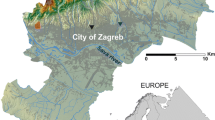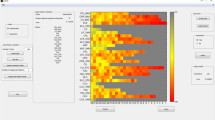Abstract
Prediction of landslide movements with practical application for landslide risk mitigation is a challenge for scientists. This study presents a methodology for prediction of landslide movements using random forests, a machine learning algorithm based on regression trees. The prediction method was established based on a time series data gathered by two years of monitoring on landslide movement, groundwater level and precipitation by the Kostanjek landslide monitoring system and nearby meteorological stations in Zagreb (Croatia). Because of complex relations between precipitations and groundwater levels, the process of landslide movement prediction is divided into two separate models: (1) model for prediction of groundwater levels from precipitation data; and (2) model for prediction of landslide movements from groundwater level data. In a groundwater level prediction model, 75 parameters were used as predictors, calculated from precipitation and evapotranspiration data. In the landslide movement prediction model, 10 parameters calculated from groundwater level data were used as predictors. Model validation was performed through the prediction of groundwater levels and prediction of landslide movements for the periods from 10 to 90 days. The validation results show the capability of the model to predict the evolution of daily displacements, from predicted variations of groundwater levels, for the period up to 30 days.
Access this chapter
Tax calculation will be finalised at checkout
Purchases are for personal use only
Similar content being viewed by others
References
Breiman L (2001) Random forests. Mach Learn 45:5–32
Brenning A (2005) Spatial prediction models for landslide hazards: review, comparison and evaluation. Nat Hazards Earth Syst Sci 5:853–862
Catani F, Lagomarsino D, Segoni S, Tofani V (2013) Landslide susceptibility estimation by random forests technique: sensitivity and scaling issues. Nat Hazards Earth Syst Sci 13:2815–2831. doi:10.5194/nhess-13-2815-2013
Caruana R, Niculescu-Mizil A (2006) An empirical comparison of supervised learning algorithms. In: Proceedings of the 23rd international conference on machine learning, pp 161–168. doi:10.1145/1143844.1143865
Gajić-Čapka M, Zaninović K (2008) Climate of Croatia. In: Zaninović K (ed) Climate atlas of Croatia, 1961–1990 and 1971–2000. Croatian Meteorological and Hydrological Service, Zagreb, pp 15–17
Goetz JN, Brenning A, Petschko H, Leopold P (2015) Evaluating machine learning and statistical prediction techniques for landslide susceptibility modeling. Comput Geosci 81:1–11. doi:10.1016/j.cageo.2015.04.007
James G, Witten D, Hastie T, Tibshirani R (2014) An introduction to statistical learning with applications in R. Springer, New York
Krkač M (2015) A phenomenological model of the Kostanjek landslide movement based on the landslide monitoring parameters. Ph.D. thesis, Faculty of Mining, Geology and Petroleum Engineering, University of Zagreb, Zagreb, Croatia (In Croatian)
Krkač M, Mihalić Arbanas S, Arbanas Ž, Bernat S, Špehar K, Watanabe N, Nagai O, Sassa K, Marui H, Furuya G, Wang C, Rubinić J, Matsunami K (2014) Review of monitoring parameters of the Kostanjek Landslide (Zagreb, Croatia). In: Sassa K, Canuti P, Yin Y (eds) Proceedings of the 3rd world landslide forum ‘landslide science for a safer geoenvironment’, Volume 2 ‘methods of landslide studies’. Springer, Netherland, pp 637–645
Micheletti N, Foresti L, Robert S, Leuenberger M, Pedrazzini A, Jaboyedoff M, Kanevski M (2014) Machine learning feature selection methods for landslide susceptibility map**. Math Geosci 46:33–57. doi:10.1007/s11004-013-9511-0
Mihalić Arbanas S, Arbanas Ž, Krkač M (2013) Comprehensive landslide monitoring system: the Kostanjek Landslide case study, Croatia. In: Sassa K, He B, McSaveney M, Osamu N (eds) ICL landslide teaching tools. International Consortium on Landslides, Kyoto, pp 158–168
Ortolan Ž, Pleško J (1992) Repeated photogrammetric measurements at sha** geotechnical models of multi-layer landslides. Rudarsko-geološko-naftni zbornik 4:51–58
Pourghasemi HR, Kerle N (2016) Random forests and evidential belief function-based landslide susceptibility assessment in Western Mazandaran Province, Iran. Environ Earth Sci 75(185):1–17. doi:10.1007/s12665-015-4950-1
Segoni S, Lagomarsino D, Fanti R, Moretti S, Casagli N (2014) Integration of rainfall thresholds and susceptibility maps in the Emilia Romagna (Italy) regional-scale landslide warning system. Landslides 12(4):773–785. doi:10.1007/s10346-014-0502-0
Stanić B, Nonveiller E (1996) The Kostanjek landslide in Zagreb. Eng Geol 42:269–283
Stumpf A, Kerle N (2011) Object-oriented map** of landslides using random forests. Remote Sens Environ 115:2564–2577. doi:10.1016/j.rse.2011.05.013
Trigila A, Iadanza C, Esposito C, Scarascia-Mugnozza G (2015) Comparison of logistic regression and random forests techniques for shallow landslide susceptibility assessment in Giampilieri (NE Sicily, Italy). Geomorphology 249:119–136. doi:10.1016/j.geomorph.2015.06.001
Venables WN, Smith DM (2014) An introduction to R: a programming environment for data analysis and graphics version 3.1.2. http://www.r-project.org/. Accessed 17 Dec 2015
Vorpahl P, Elsenbeer H, Märker M, Schröder B (2012) How can statistical models help to determine driving factors of landslides? Ecol Model 239:27–39
Youssef AM, Pourghasemi HR, Pourtaghi ZS, Al-Katheeri MM (2015) Landslide susceptibility map** using random forest, boosted regression tree, classification and regression tree, and general linear models and comparison of their performance at Wadi Tayyah Basin, Asir Region, Saudi Arabia. Landslides. doi:10.1007/s10346-015-0614-1
Author information
Authors and Affiliations
Corresponding author
Editor information
Editors and Affiliations
Rights and permissions
Copyright information
© 2017 Springer International Publishing AG
About this paper
Cite this paper
Krkač, M., Mihalić Arbanas, S., Arbanas, Ž., Bernat Gazibara, S., Sečanj, M. (2017). Prediction of the Kostanjek Landslide Movements Based on Monitoring Results Using Random Forests Technique. In: Mikoš, M., Arbanas, Ž., Yin, Y., Sassa, K. (eds) Advancing Culture of Living with Landslides. WLF 2017. Springer, Cham. https://doi.org/10.1007/978-3-319-53487-9_30
Download citation
DOI: https://doi.org/10.1007/978-3-319-53487-9_30
Published:
Publisher Name: Springer, Cham
Print ISBN: 978-3-319-53486-2
Online ISBN: 978-3-319-53487-9
eBook Packages: Earth and Environmental ScienceEarth and Environmental Science (R0)




